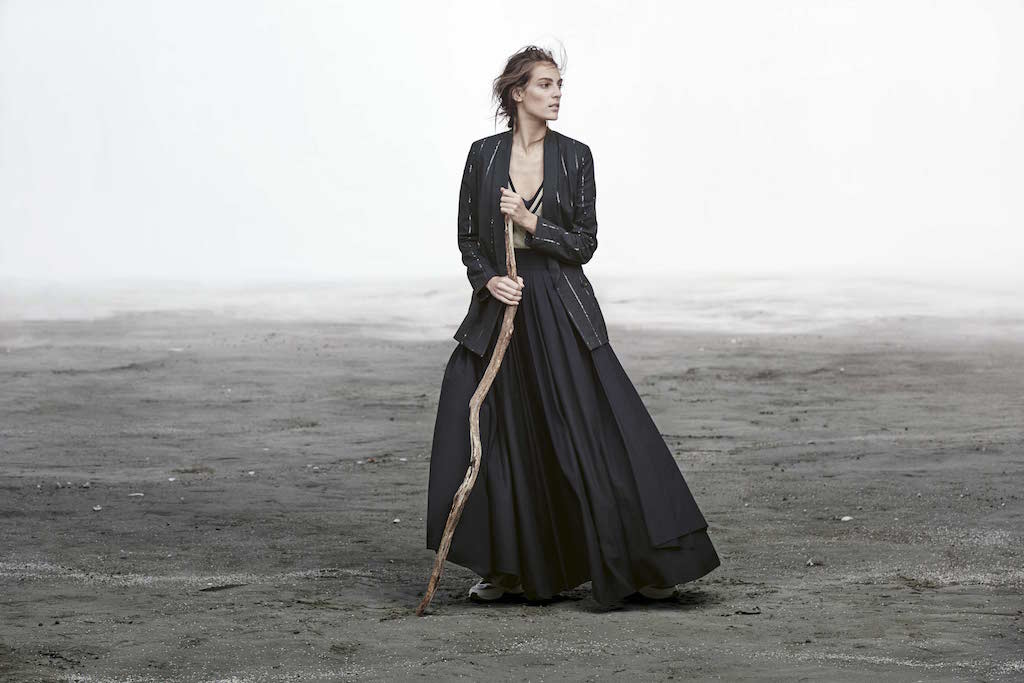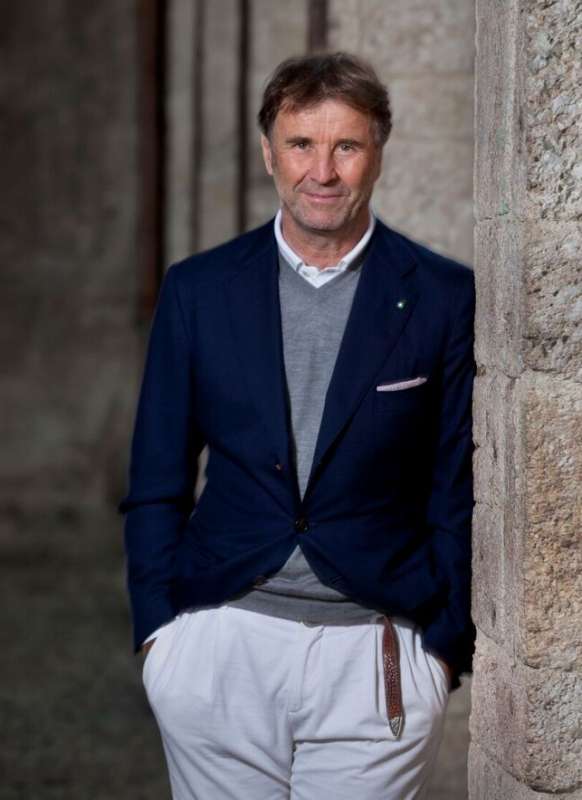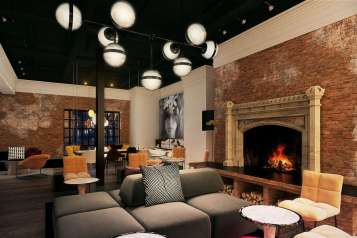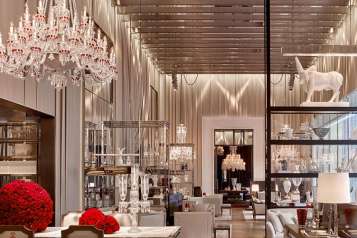Paris, Milan, New York, London…and Solomeo? By any definition, this Renaissance village would never qualify as a fashion capital— there are no couture maisons fronting its cobblestoned streets, no biannual runway show hoopla that brings in journalists and paparazzi to discover the next big thing in style. But if there was ever a place that influenced how the elite of the world dress now, it is this tiny town perched on a hilltop in central Umbria.
And that’s because of Brunello Cucinelli, often referred to as “the king of cashmere,” who directs a billion-dollar company based here and a label that has, with uncanny prescience, anticipated and delivered what one-percenters want as they sashay from their copter rides to the Hamptons and to their ski getaways in Aspen and Courchevel. From this glorious, remote countryside perch, Cucinelli has crafted a fresh idiom of modern luxe, and his ultra high-quality sportswear had been adopted by moguls and mogulettes around the world as their go-to uniform. Yes, much of boldface Hollywood is his customer—Gwyneth Paltrow, Jennifer Garner, Daniel Craig, among them—in fact most boldfacers everywhere crave his sportivo take on understated chic.
You have to marvel at how Cucinelli does it. At first look, Solomeo seems more immersed in the spirit of the Renaissance (many of the town’s buildings date from that period) than in today’s social media-saturated zeitgeist. Cucinelli himself can seem like a product of the Renaissance, that rare designer who regularly reads and quotes Aurelius, Socrates, and Seneca. Yet Solomeo, which has only 500 people— many employed by the fashion company—is the root and source of all things Cucinelli. “It is the heart of where we work,” says the designer. “The environment is tranquil and serene, which allows my creativity to flourish.”
Cucinelli’s success story is as unusual as the decision to headquarter his com- pany far from Milan, long the stylish nexus for major Italian brands. (Cucinelli grew up in a small town near Solomeo, where his wife, Federica, is from.) In 1978, when names like Armani, Missoni, Ferre, and Krizia were dominating the fashion scene, Cucinelli was casting about for a career—he had dropped out of engineering school and was studying philosophy on his own—hardly what you’d think of as typical training for a future fashion star. All he knew then was that he wanted a working life that would be very different from his father’s. “When I was growing up, my father was a factory worker, and he endured constant humiliation and mistreatment,” says Cucinelli. (His father’s colleagues taunted the elder Cucinelli, who had originally been a farmer, for his lack of education.) “After seeing the constant pain in his eyes, I decided that is not how I wanted to live my life.”
Umbria, his home region, is known for its fine knitwear and artisanal craftsmanship, so he took a small gamble on his future, borrowing $500 to produce a first line, which consisted of seven brightly colored cashmere sweaters–and never looked back. For his first two decades in business, Cucinelli focused on producing fine cashmere items as well as on developing a work environment where no one would ever be treated as his father had been. “When I started my company, I promised myself I would build my brand with the purpose of humanism and ethical capitalism,” Cucinelli says. He reasons that the strategy is not only the moral thing to do, it’s also better for business. “By emphasizing people and their needs, I find they have more passion, commitment and dedication.”
The company grew fast and, with it, the commitment to Solomeo. A former castle was transformed into a factory; the company dining room was built into a villa dating from the Renaissance. The Cucinellis moved into and refurbished another Renaissance-era property. Additional buildings were salvaged, streets and piazzas repaired, as was the local church. A library was created, and an arts and crafts school and a theater added. “In 1985, I decided to restore the village because I had a vision for creating something greater. I felt that in order to create a beautiful product, our employees needed to be working in a beautiful place,” he says, adding that not being in a big city works to everyone’s advantage “because it limits distractions” and allows for more creativity. For Cucinelli, whose financial success (the company went public in 2012 and now has a billion-dollar valuation) would allow him to live anywhere, Solomeo will “always remain my home.”
While this glorious, peaceful setting helps the creative psyche flourish, if it’s far removed from the fashion action can it keep Cucinelli and his team in touch with the fast-changing retail world and the needs of their high-flying, often urban-centric customers? A key reason why the location works and the company has enjoyed so much success is Cucinelli’s radically intuitive fashion aesthetic. You don’t need to be working on the Via Montenapoleone or Bond Street if your credo transcends trend seasonality or if your clothes speak to a lifestyle and to insiders who have it all but don’t want to shout that they do, and whose changing needs develop organically rather than to the beat of the fashion calendar.
It also helps that elite clients want what Cucinelli himself has always wanted: an easy luxe, an unforced chic, superb fabric quality, style without flamboyance or logos. His tastes have dovetailed perfectly with the curated, dressed-down style that has redefined fashion in the last decade and have smoothly positioned the company to capitalize on the hot “athleisure” trend, although from a privileged perch. “Luxury sportswear has been at the core of our brand from the start,” Cucinelli explains. “I have always had a desire to combine lightweight, chic and sporty elements so people feel comfortable, yet well dressed.”

Stepping back from the fashion fray to think beyond it has clearly been good for business, but Cucinelli says Solomeo has never been an ivory (by the way, a favorite shade in his collections) tower. He also credits his company’s success to maintaining a constant dialogue with customers at boutiques around the world.
What he hears he acts upon: Beyond a more casual approach to dressing, Cucinelli loyalists want the best of both the old (fine craftsmanship) and the new (the latest tech-enhanced textiles) in seasonless fabrics that can cross time zones with ease.
“The cashmere I use is very special,” says Cucinelli, who has worked with the same supplier, Cariaggi, for more than 30 years and sources his fibers from Mongolia and China. “It comes from goats that have to endure extreme climates, so their fur is able to keep them warm during cold weather and cool during warm weather.” But Cucinelli sees hyper-exclusive fibers as only one part of the equation: “The treatment of the fabric is equally important,” he says, noting that while artisinal workmanship is criticial to how fine cashmeres are made, selectively applying the latest tech to knitwear is essential for a modern luxury business’s growth, too. “For example, I developed a new technology a few seasons ago to create our Teddy Bear fabric, an ultra-luxe and cozy cashmere with a textured finish.” (Yarns are frayed to create a plush-animal effect.)
Fabrics have long defined what’s special about Italian ready-to-wear, but a fashion brand cannot live by feather-soft cashmere alone. Designers like Armani, who reimagined the jacket, and Miuccia Prada, who has constantly re-calculated form and shape in her collections, became global brands with bold innovations. Cucinelli has had an enormous, if perhaps quieter impact with silhouettes, too, shrinking the blazer (probably forever) and moving it away from its boxy roots with a short, “one-and-a-half,” buttoned slim cut. “I wanted to create a jacket that enhanced the physicality of the male torso by keeping the lines close to the body,” he says. There are eco benefits, too: Cucinelli notes proudly that the one-and-a-half-breasted jacket uses less material than a classic double-breasted one. He says he set buttons 25 percent closer together than they are on a traditional blazer “so a man can comfortably wear the jacket unbuttoned.” Cucinelli, who started with women’s cashmeres, then added men’s items and in 2000 “the total look” (ready-to-wear), says he has an affinity for menswear. Aside from his own insights into how men want to dress, he feels a “brand is strong when its menswear is strong.”
Jackets are central to Cucinelli’s 2016 spring/summer collections—here the majority are made in unstructured cuts with light fabrics that allow for layering—something Cucinelli keeps reimagining for the luxury customer with fresh high-end plays of rich textures (think wafer-thin suedes or two linen blazers over summer-weight cashmeres). They’re essential to another key move on Cucinelli’s part. With a nod to the soaring demand for athlesiure wear, he’s introducing new Leisure Fit styles with relaxed cuts and lower waistlines, along with jogger trousers in wool fabrics. For the designer, who likes to play soccer—in cashmere—the blazer is simply the clothing item that helps take athleisure wear from the playing fields to the office. “A man can go from the gym to a business lunch, for example, by combining cashmere joggers with a cardigan and sport jacket,” he says (and does). With two stores in East Hampton (at 55 Main Street and 39 Newton Lane), Cucinelli thinks his East End customers will respond well to the new athleisure styles, finding Hamptonites “very much in line with our brand aesthetic.” He says the best sellers at his stores on the East End have included lightweight outerwear, two-ply cashmeres, scarves, and runners for women, while men scoop up the cashmere hoodies, five-pocket jeans and (in cooler weather) down vests. Asked about his own summer go-to, Cucinelli describes a look that sounds like his prototypical customer’s: “linen or cotton pants, a crisp white cotton shirt, light cashmere sweater, unlined sports jacket, and sneakers.”
For all his success in building a global billion-dollar brand, Cucinelli seems proudest of the business culture he created, “one that respects human dignity,” as he puts it. “I have always felt profit for profit’s sake was not enough.” Appropriately, salaries at Brunello Cucinelli are reputedly 20 percent higher than for similar jobs in the region; likewise, 20 percent of profits go to the designer and Federica’s foundation, which supports arts programs and village-improvement projects. He says reading the ancient philosophers as well as remembering what his father endured have always informed his management ethos. “Through these great thinkers, I’ve created work with people at its core, a humanistic capitalism that gives workers an important objective going beyond material goods. We must all work for a higher purpose.”





















